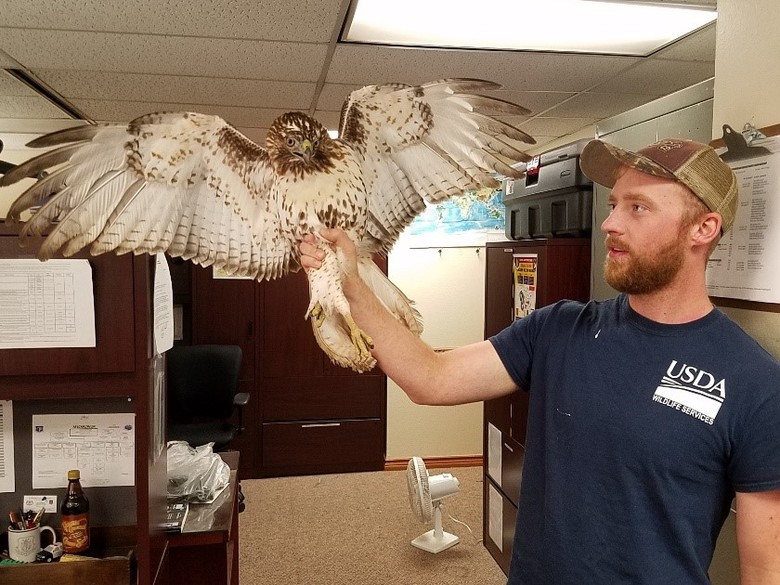
Hawks and falcons are an essential part of the ecosystem and are one of nature’s instinctive predators. Although these natural aviators are beneficial to the environment, they can pose a threat to the safety of Airmen, aircraft and vulnerable wildlife.
The 97th Air Mobility Wing Bird/Wildlife Aircraft Strike Hazard, or BASH, program, expanded with the addition of the Predatory Bird Relocation Program.
After seeing the risks predatory birds, or raptors, have when they live near or on airfields, Adam Kohler, a U.S. Department of Agriculture Wildlife Services wildlife biologist at Altus Air Force Base, created the Predatory Bird Relocation Program, which safely removes birds that have the potential to injure themselves or aircrew.
“I work for the USDA Wildlife Services which acts kind of like the government’s wildlife damage management program,” Kohler said. “One of the big areas we work in are airfields. We use the BASH program to help keep the public and aircraft safe from accidents that may happen with wildlife.”
The Predatory Bird Relocation Program is an important aspect in forwarding the mission of the 97th AMW. Each year, the Air Force spends approximately $100 million repairing damage to aircraft from birds and other wildlife. Since Kohler founded the program in the fall of 2018, more than 20 raptors have been safely captured and relocated away from the airfield saving Altus AFB time, lives and money.
“While hawks and falcons are less abundant than other birds found in this area, they are one of the species with the highest risk of getting hit,” Kohler said. “Although there is less of them out there, they get struck by aircraft more often, and because of their size they inflict more damage when they are hit. That is why we created the program specific to relocate the raptors.”
When a raptor is within a close enough range of the airfield to become a hazard, Kohler sets out harmless, simple traps to capture the bird. Once the raptor is caught, Kohler places a tracking band on its foot and relocates it to a safer environment.
“By us going out there and banding the raptors, it helps out U.S. Fish and Wildlife Services and any agencies that are studying wildlife,” Kohler said. “It’s a great cooperative effort between us and every other wildlife research agency towards gaining knowledge from and understanding different species.”
Each tracking band has a specific number on it to help identify the bird in the future. This is a very important part of the relocation process because it can help identify which birds return to the airfield once they have been relocated. If a banded bird does return, it is relocated to a different environment, hopefully to keep the raptor satisfied at its new location.
“Banding the birds is an essential part, nationwide, to the agencies research of the effectiveness in relocating raptors,” Kohler said. “Throughout our research we have found that more than 90 percent of the relocated birds have stayed in their new location, away from the airfield. It’s good because this data helps us show that catching and relocating these birds actually keeps them away and safe, and not returning.”
Although predatory birds are necessary in local environments, flying too close to an airfield is a threat to the raptors’ own lives and the safety of Airmen. By relocating these raptors to a safer location, Kohler and the USDA Wildlife Services team help keep the 97th AMW safe and mission ready.
This is a press release from the US Air Force. By Airman 1st Class Breanna Klemm, 97th Air Mobility Wing Public Affairs


Bulloch Public Safety
12/12/2025 Booking Report for Bulloch County

Georgia Politics
Gov. Kemp to Sen. Padilla: Stop Playing Politics With American Hero

Bulloch Public Safety
12/11/2025 Booking Report for Bulloch County

Bulloch Public Safety
11/24/2025 Booking Report for Bulloch County

Bulloch Public Safety
12/01/2025 Booking Report for Bulloch County

Bulloch Public Safety
11/17/2025 Booking Report for Bulloch County

Bulloch Public Safety
11/26/2025 Booking Report for Bulloch County

Bulloch Public Safety
12/08/2025 Booking Report for Bulloch County






